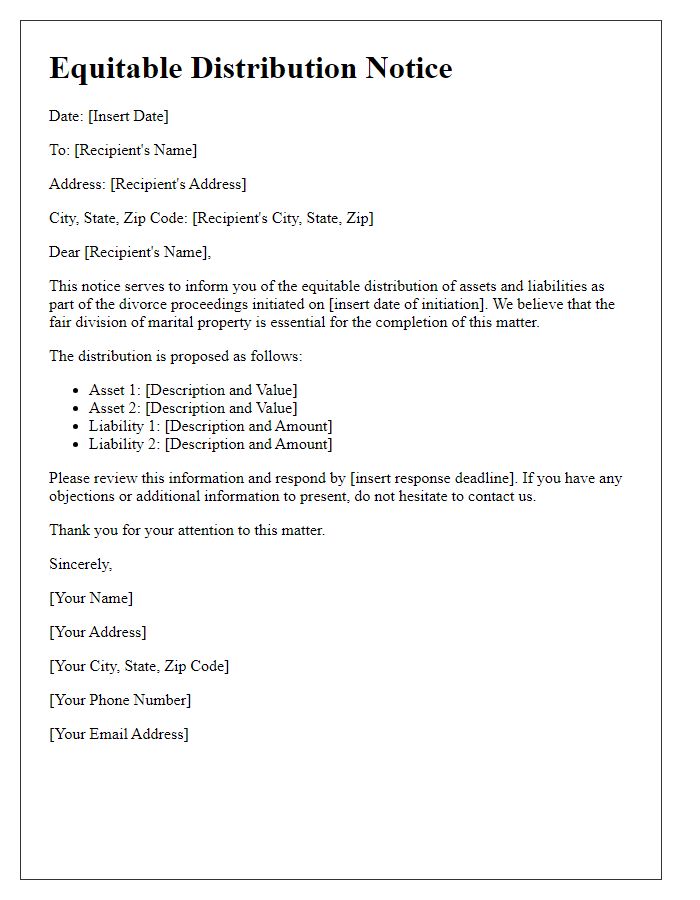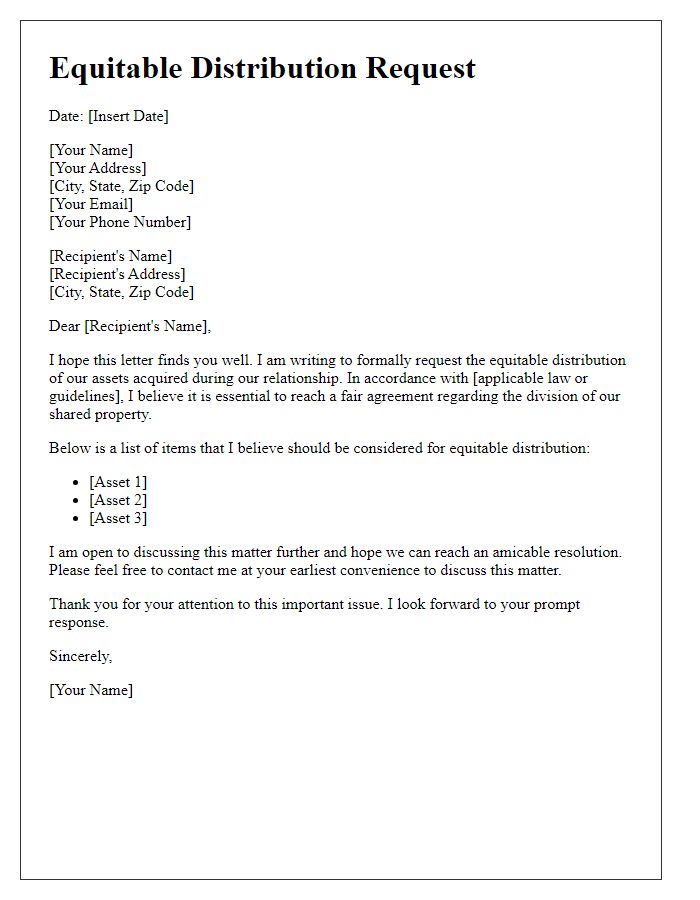Are you considering an equitable distribution agreement and unsure how to get started? Crafting this type of letter can feel overwhelming, but it doesn't have to be! With the right template, you can ensure that all parties involved clearly understand their rights and obligations. Ready to dive deeper into the details? Let's explore how to create the perfect equitable distribution agreement!

Clear Identification of Parties
An equitable distribution agreement is vital in divorce proceedings, emphasizing the fair separation of assets and liabilities between parties involved. Clear identification of parties (typically the husband and the wife), including full names, addresses, and the date of marriage, sets the foundation for this legal document. For instance, John Smith residing at 123 Main Street, Springfield, and Jane Doe living at 456 Elm Street, Springfield, should be accurately detailed alongside the marriage date of June 15, 2010. This clarity ensures that both parties understand their rights and obligations, fostering transparency throughout the distribution process. The agreement can later include sections on asset categorization, such as real estate properties, bank accounts, and personal belongings, further ensuring a comprehensive understanding of shared financial responsibilities.
Comprehensive Asset Inventory
A comprehensive asset inventory is essential for an equitable distribution agreement, detailing all parties' assets for fair division. This inventory includes real estate properties (such as family homes located in urban areas, valued at $350,000), financial accounts like joint checking accounts with balances totaling $50,000, retirement funds (including a 401(k) worth $150,000), and personal property (valuables like jewelry appraised at $20,000). Additionally, business interests (like a partnership in a local restaurant generating annual revenue of $300,000) and liabilities (such as credit card debts amounting to $15,000) must also be accounted for. Accurate documentation ensures transparency and supports mutual agreement on asset division, fostering a smoother transition during proceedings.
Fair Division Terms
An equitable distribution agreement provides a framework for the fair division of marital assets during divorce proceedings. Essential elements include identifying all assets, such as real property (houses, land), financial accounts (bank accounts, retirement funds), and personal belongings (furniture, vehicles). The agreement typically outlines the valuation process of these assets, ensuring both parties agree on fair market value, considering conditions like appraisal methods or recent sales data from local property markets. Additionally, it addresses liabilities, including debts (mortgages, credit card debts) shared by both partners, ensuring a comprehensive picture of financial obligations. The agreement may include terms regarding spousal support (alimony) and the division of future earnings, especially if one partner sacrificed career advancements for home responsibilities. It emphasizes mediation considerations to amicably resolve disputes, minimizing potential litigation costs, which often average thousands in legal fees. Legal consultation is usually recommended to ensure compliance with state laws, which can vary significantly; for example, states like California follow community property laws, while others like New York favor equitable distribution models. A well-structured agreement can lead to a smoother transition for both parties in the wake of this life-altering event.
Legal Compliance and Language
An equitable distribution agreement outlines how marital assets and debts are divided between partners during divorce proceedings, ensuring fairness. The agreement must comply with the applicable state laws, such as those outlined in the Uniform Marriage and Divorce Act. Clear terminology is crucial, defining terms like "marital property," which includes all assets acquired during the marriage, such as real estate, vehicles, and retirement accounts. Legal language must articulate each party's rights, responsibilities, and the specific distribution of assets; for instance, assigning percentages to real estate valued at $300,000 or retirement savings of $150,000. Including clauses for potential future changes enhances compliance with legal standards, ensuring both parties' interests are legally protected throughout the separation process.
Dispute Resolution Clause
An equitable distribution agreement is essential for outlining the division of marital assets, particularly during divorce proceedings in states like California. A Dispute Resolution Clause serves as a critical component of such agreements, providing a structured method for resolving conflicts. This clause often stipulates the use of mediation, which typically occurs before any litigation, allowing couples to negotiate amicably with the guidance of a neutral third party. If mediation fails, arbitration may follow, where an arbitrator makes binding decisions regarding asset division. This process aims to minimize court involvement, reduce costs--potentially thousands of dollars--and decrease emotional stress for both parties. Implementing a time frame within the clause, such as requiring disputes to be resolved within 30 days, can further facilitate efficient conflict resolution. By establishing clear procedures, parties can maintain a focus on reaching equitable solutions for asset distribution while ensuring both voices are heard.













Comments